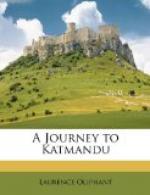However, it is better to have a railway on a doubtful line than none at all; the shareholders are guaranteed 5 per cent., and the Government is rich and can afford to pay them. So let us wish success to the experimental railway, and hope that the means of transport may soon be more expeditious than they are at present.
It will doubtless open out the resources of the country, though I cannot but think, for many reasons, that it would have been more judicious to have made the line from Allahabad to Delhi the commencement of the railway system in this part of India, instead of leaving it for a continuation of the line that is now being made.
The bridges we passed over are all on the suspension principle, and do credit to the government; the rivers are difficult to bridge in any other way, as the rains flood them to such an extent that arches will not remain standing for any length of time. It took us two hours to cross the Soan, which we forded or ferried according as the streams between the sand-banks were deep or shallow. This large river is at times flooded to so great an extent that it is one of the most serious obstructions to the railway.
It was not until the morning of the seventh day after leaving Calcutta that we found ourselves on the banks of the Ganges. The Holy City loomed large in the grey dawn of morning, with its tapering minarets barely discernible above it, looking like elongated ghosts.
We were ferried across in a boat of antique construction, better suited for any other purpose than the one to which it was applied, and landed in the midst of the ruins caused by the dreadful explosion of gun-powder that had taken place the previous year: it had occasioned a fearful destruction of property and loss of life, and many hairbreadth escapes were recounted to us. We were told, indeed, that two children, after being buried for five days, were dug out alive; two officers were blown out of the window of an hotel, one of whom was uninjured, the other was only wounded by a splinter, whilst the Kitmutgar, who was drawing a cork close to them at the time, was killed on the spot.
In the course of an hour after leaving this scene of desolation we reached the hospitable mansion which was destined to be our home during our short stay in Benares.




